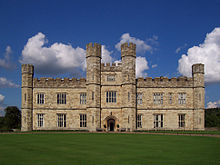| SirCheney Culpeper | |
|---|---|
| Born | 1601 (1601) |
| Died | 1663 (aged 61–62) |
| Nationality | British |
| Alma mater | Hart Hall, Oxford |
| Scientific career | |
| Fields | Alchemy |
Sir Cheney Culpeper (1601–1663) was an English landowner, a supporter of Samuel Hartlib, and a largely non-political figure of his troubled times, interested in technological progress and reform. His sister Judith was the second wife of John Colepeper, 1st Baron Colepeper.
Landowner
He was the eldest son of Sir Thomas Colepeper of Hollingbourne, Kent and Elizabeth Cheney of Guestling, Sussex. After legal training, he was knighted in 1628. He had an estate at Great Wigsell, Salehurst, East Sussex, which he bought from his brother-in-law Lord Colepeper, but had possession of it only briefly. He bought Elmley Castle, Worcestershire in 1650. He lived mainly at Leeds Castle, which his father had purchased for his sons in 1632. Being later disinherited by his father, he became heavily indebted. During the English Civil War, he was a convinced Parliamentarian, unlike his father who was a staunch Royalist, and sat on the County Committee for Sequestration. This clash of opinions no doubt explains his father's decision to disinherit him. He never regained possession of his estates, and died a ruined man only a year after his father.

Family
He married his cousin Elizabeth Stede, daughter of Sir John Stede of Harrietsham (the common ancestor was Joan Pordage, who married firstly William Stede and secondly Francis Colepeper). They had two surviving daughters, Cicely, who married William Cage (died 1676) of Milgate House, Thurnham, a lawyer, by whom she was the mother of the politician William Cage (died 1738), and Elizabeth, fourth wife of Christopher Milles of Herne Bay. Elizabeth was still alive in 1710, when we found her corresponding with her cousin, the writer Elizabeth Freke (who was the daughter of Sir Cheney's sister, the elder Cecily).
Hartlib circle
Main article: Hartlib CircleOf the Hartlibians, he had most to do with Benjamin Worsley. He was interested in alchemy, but most of all in agricultural topics. While on the Parliamentarian side, he was a moderate, against the more theocratic tendencies. He had contacts in Parliament; but insufficient influence to make a real difference in the attitude to Hartlib's projects.
References
- Stephen Clucas, The correspondence of a XVII-century 'chymical gentleman': Sir Cheney Culpeper and the chemical interests of the Hartlib circle. Ambix 40, 1993. p147-170
- M. J. Braddick and M. Greengrass, editors, The Letters of Sir Cheney Culpepper 1641-1657 edited by in Seventeenth Century Political and Financial Papers, Camden Fifth Series volume 7 (1997)
Notes
- Cheyney Culpeper, Cheney Culpepper, Cheyney Culpepper, Cheney Colepeper, Cheyney Colepeper, Cheney Colepepper.
- Jennifer Stine has documented the exchange between Sir Cheney Culpeper and Hartlib, during which Culpeper repeatedly asked for his wife's recipe collection to be returned.
- Hugh Trevor-Roper, Religion, the Reformation and Social Change (1967), p. 283.
- He was a B.A. of Hart Hall, Oxford, and a member of the Inner Temple, according to Robert F. Young, Bohemian Scholars and Students at the English Universities from 1347 to 1750, The English Historical Review, Vol. 38, No. 149 (Jan., 1923), pp. 72-84.
- "Great Wigsell". Archived from the original on 2007-06-08. Retrieved 2007-07-15., Archived 2007-06-24 at the Wayback Machine.
- University of London British History Online History of the county of Worcester; also Morgue and Godden , Atch Lench.
- "The Remembrances of Elizabeth Freke 1671-1714" edited by Ralph A. Anselment Cambridge University Press (2001) p.154
- John T. Young, Faith, Medical Alchemy and Natural Philosophy (1998), p. 234-6.
- for comments on improved beehives.
- In letters written to his friend Samuel Hartlib, shortly after he had read Gangraena, Cheney Culpeper described his efforts to get a petition from Kent that would attack any power not based on popular consent as embodied in the House of Commons, and oppose any compulsive Presbyterian church government. PDF Archived September 29, 2007, at the Wayback Machine, p. 372.
- J. P. Cooper, Social and Economic Policies under the Commonwealth, p. 125, in The Interregnum (1972, edited by G. E. Aylmer.
- Parliamentary appointment (as Cheyney Culpepper)
- That Cheyney Culpeper and John Sadler were committed supporters and promoters of Hartlib and his schemes is beyond dispute, but their personal influence was not vast. Young, p. 248.
External links
- Culpepper Connections! The Culpepper Family History Site: Sir Cheney Culpeper of Leeds Castle 1601-1663 (biography)
- Stirnet Ltd: Families Database: Colepeper3